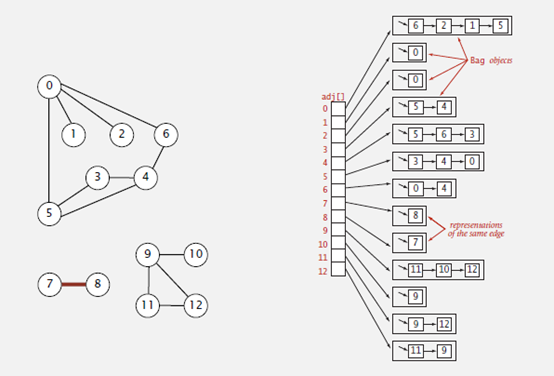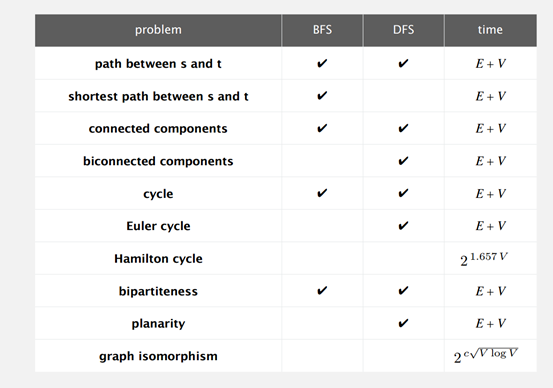图(一):无向图的深度优先遍历、广度优先遍历及连通分量
无向图:
一些关于图的定义:
图是由一组顶点和一组能够将两个顶点相连的边组成。
连通图:如果从任意一个顶点都存在一条路径到达另一个任意顶点,就称为连通图,一个非连通图由若干连通的部分组成,都称为极大连通子图。
无向图:即连接两个顶点的边是没有方向的。
无向图的数据结构:
使用邻接表来表示图:

如上图所示,使用一个链表数组来表示图,其中数组的索引表示所有的顶点,每个数组中存放的链表表示所有与此顶点相连的顶点,也可以理解为边。
数据结构如下:
先看链表:
public class LinkedList<T> { private Integer N = 0; private Node<T> root; //链表的结点 @SuppressWarnings("hiding") class Node<T> { T value; Node<T> next; public Node(T t,Node<T> node) { this.value = t; this.next = node; } } //添加一个结点 public void add(Node<T> node) { if(root == null) root = node; else { Node<T> temp = root; root = node; root.next = temp; } N++; } public void add(T t) { Node<T> node = new Node<T>(t,null); if(root == null) root = node; else { Node<T> temp = root; root = node; root.next = temp; } N++; } //链表的节点数 public Integer size() { return N; } public Node<T> getRoot() { return root; } //遍历链表 public void traverse() { Node<T> node = root; while(node != null) { System.out.print(node.value + " "); node = node.next; } } //获取链表上的所有节点的值,返回一个数组 public Integer[] getAllValue(LinkedList<T> linkedList) { if(linkedList.root == null) return null; Integer[] result = new Integer[linkedList.size()]; Node<T> node = linkedList.root; Integer i = 0; while(node != null) { result[i++] = (Integer)node.value; node = node.next; } return result; } }
图的数据结构:
public class UndiGraphBase { //顶点数目 private Integer V; //边的数目 private Integer E; //邻接表 public LinkedList<Integer>[] adj; //创建一个含有V个顶点但不含有边的图 @SuppressWarnings("unchecked") void graph(Integer V) { this.V = V; this.E = 0; adj = (LinkedList<Integer>[]) new LinkedList[V]; for(int v=0;v<V;v++) { adj[v] = new LinkedList<Integer>(); } } public Integer V() { return V; } public Integer E() { return E; } //添加一条边 public void addEdge(Integer v,Integer w) { adj[v].add(w); adj[w].add(v); E++; } //遍历 public void traverse() { for(int i=0;i<V;i++) { System.out.print(i + ": "); adj[i].traverse(); System.out.println(); } } //获取某个顶点所有相邻的顶点 public Integer[] getAllValueByIndex(Integer i) { return adj[i].getAllValue(adj[i]); } }
只要静下心来看,这些代码都比较简单,并且都有注释,就不多说了。
深度优先遍历
深度优先遍历类似于一个人走迷宫:

如图所示,从起点开始选择一条边走到下一个顶点,没到一个顶点便标记此顶点已到达。
当来到一个标记过的顶点时回退到上一个顶点,再选择一条没有到达过的顶点。
当回退到的路口已没有可走的通道时继续回退。
先给出一个已经构建好的图,之后的代码都建立在这个图的实例上:
public class Instance { public static UndiGraphBase getInstance() { UndiGraphBase undiGraphBase = new UndiGraphBase(); undiGraphBase.graph(13); undiGraphBase.addEdge(0, 5); undiGraphBase.addEdge(4, 3); undiGraphBase.addEdge(0, 1); undiGraphBase.addEdge(9, 12); undiGraphBase.addEdge(6, 4); undiGraphBase.addEdge(5, 4); undiGraphBase.addEdge(0, 2); undiGraphBase.addEdge(11, 12); undiGraphBase.addEdge(9, 10); undiGraphBase.addEdge(0, 6); undiGraphBase.addEdge(7, 8); undiGraphBase.addEdge(9, 11); undiGraphBase.addEdge(5, 3); return undiGraphBase; } }
该实例表示的图如下:

深度遍历的顺序如下图所示:

数组marked表示索引所代表的顶点是否被访问过
数组edgeTO[]表示到达索引所代表的顶点的上一个顶点,通过对此数组的处理即可得到路径,即可以用循环,也可以用栈,因为知道每个顶点的上一个顶点,所以可以得到路径
遍历的代码如下:
public class DepthFirstPath { //所有顶点组成的数组,如果起点到某顶点可达,则为true,否则为false private boolean[] marked; //起点 private final Integer startV; //用数组来表示路径树,表示起点到可达顶点的路径。保存的是到达此顶点的上一个顶点 private Integer[] edgeTo; public DepthFirstPath(UndiGraphBase G,Integer startV) { marked = new boolean[G.V()]; edgeTo = new Integer[G.V()]; this.startV = startV; dfs(G,startV); } public void dfs(UndiGraphBase G,Integer v) { marked[v] = true; Integer[] allNodeValues = G.getAllValueByIndex(v); if(allNodeValues == null) return; for(int i=0;i<allNodeValues.length;i++) { if((!marked[allNodeValues[i]])) { edgeTo[allNodeValues[i]] = v; dfs(G,allNodeValues[i]); } } } //获取顶点到v的路径 public void getPath(UndiGraphBase G,Integer v) { if(!hasPathTo(v)) return; //存储路径 Stack<Integer> path = new Stack<Integer>(); for(int i=v;i!=startV;i = edgeTo[i]) path.push(i); //加入起点 path.push(startV); //打印栈(即起点startV到v的路径) System.out.println(path.toString()); } //从起点startV是否有路径通往v(即是否可达) public boolean hasPathTo(Integer v) { return marked[v]; } public static void main(String[] args) { UndiGraphBase G = Instance.getInstance(); DepthFirstPath depthFirstPath = new DepthFirstPath(G,0); depthFirstPath.getPath(G, 3); } }
其实整个代码是比较好懂的,主要是edgeto数组需要理解一下。
广度优先遍历
广度优先遍历其实比深度优先遍历好理解,即从起点开始,遍历所有与起点连通的顶点,再遍历与这些顶点连通的顶点,即先搜索距离起点距离为1的顶点,再遍历与起点距离为2的顶点.....

其中经edgeTo数组的意义与深度优先中edgeTo数组一样。
而distTo[]数组则表示与起点的距离,图中使用该数组只是为了便于理解,代码中可以不用,因为距离可以通过遍历edgeTO[]数组得到
广度优先遍历的代码:
public class BreadthFirstPath { //到达该顶点的最短路径是否已知 private boolean[] marked; //到达该顶点的已知路径上的最后一个顶点 private Integer[] edgeTo; //起点 private final Integer start; public BreadthFirstPath(UndiGraphBase G,Integer start) { marked = new boolean[G.V()]; edgeTo = new Integer[G.V()]; this.start = start; bfs(G,start); } private void bfs(UndiGraphBase G,Integer start) { Queue<Integer> queue = new java.util.LinkedList<Integer>(); //标记起点 marked[start] = true; queue.add(start); while(!queue.isEmpty()) { //从队列中删除下一顶点 Integer v = queue.remove(); Integer[] allNodeValues = G.getAllValueByIndex(v); for(int i=0;i<allNodeValues.length;i++) { //对于每个未被标记的顶点 if(!marked[allNodeValues[i]]) { //保存最短路径的最后一个顶点 edgeTo[allNodeValues[i]] = v; //标记它,因为最短路径已知 marked[allNodeValues[i]] = true; queue.add(allNodeValues[i]); } } } } public boolean hasPathTo(Integer v) { return marked[v]; } //获取顶点到v的路径 public void getPath(UndiGraphBase G,Integer v) { if(!hasPathTo(v)) return; //存储路径 Stack<Integer> path = new Stack<Integer>(); for(int i=v;i!=start;i = edgeTo[i]) path.push(i); //加入起点 path.push(start); //打印栈(即起点startV到v的路径) System.out.println(path.toString()); } public static void main(String[] args) { UndiGraphBase G = Instance.getInstance(); BreadthFirstPath breadthFirstPath = new BreadthFirstPath(G,0); breadthFirstPath.getPath(G, 3); } }
使用深度优先遍历获取图中的所有连通分量
public class ConnectedComponent { //顶点是否联通 private boolean[] marked; //联通分量标识符 private Integer[] id; //联通分量数目 private Integer count = 0; public ConnectedComponent(UndiGraphBase G) { marked = new boolean[G.V()]; id = new Integer[G.V()]; for(int i=0;i<G.V();i++) { if(!marked[i]) { dfs(G,i); count++; } } } public void dfs(UndiGraphBase G,Integer v) { marked[v] = true; id[v] = count; Integer[] allNodeValues = G.getAllValueByIndex(v); for(int i=0;i<allNodeValues.length;i++) { if((!marked[allNodeValues[i]])) dfs(G,allNodeValues[i]); } } //判断v和w是否联通 public boolean connected(Integer v,Integer w) { return id[v] == id[w]; } //连通分量数 public Integer count() { return count; } //v顶点所在的联通分量的标识符(0-count()-1) public Integer id(Integer v) { return id[v]; } public Integer[] getID() { return id; } public static void main(String[] args) { UndiGraphBase G = Instance.getInstance(); ConnectedComponent cc = new ConnectedComponent(G); Integer m = cc.count(); System.out.println(m + " components"); Integer[] id = cc.getID(); for(int j=0;j<m;j++) { for(int i=0;i<id.length;i++) { if(id[i] == j) { System.out.print(i + " "); } } System.out.println(); } } }
其中marked数组表示索引所代表的顶点是否已经被访问
Id数组表示索引所代表的顶点属于哪个连通分量,假如一个图总共有n个分量,那么各个连通分量分别用0,1,2....n-1表示,id数组的值即是该顶点属于第几个连通分量。
广度优先遍历与深度优先遍历的区别
深度优先遍历不断深入图中并在栈中保存了所有分叉的顶点;广度优先遍历则像扇面一般扫描图,用一个队列保存访问过的最前端的顶点。深度遍历的方式是寻找离起点更远的顶点,只在碰到死胡同时才访问进出的顶点,广度遍历则会首先覆盖起点附近的顶点,只在临近的顶点都被访问完后,才去访问更远的顶点。
深度优先遍历的路径通常较长而曲折,广度优先遍历的路径通常短而直接。
关于广度优先遍历和深度优先遍历的使用场景与效率如下图所示:

作者


